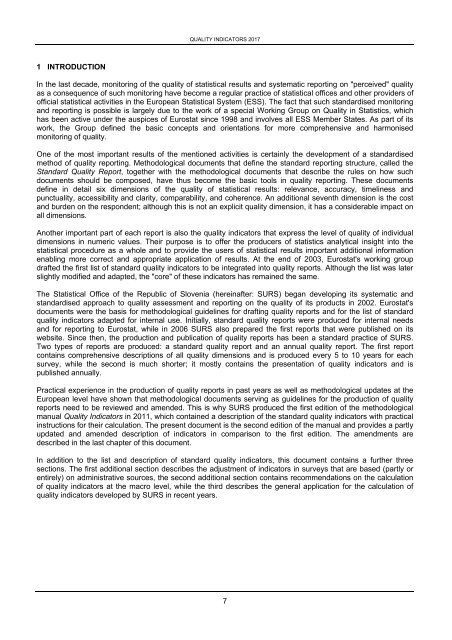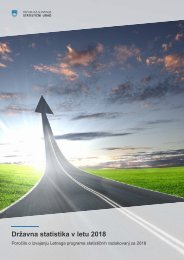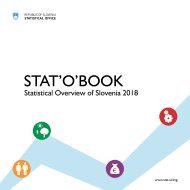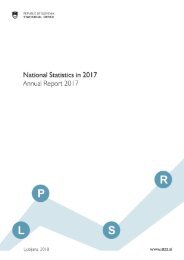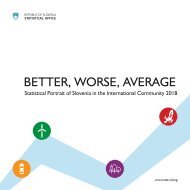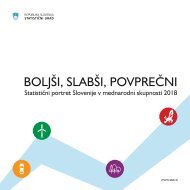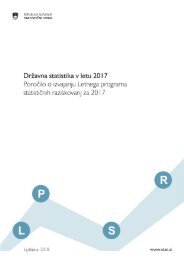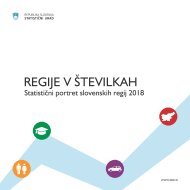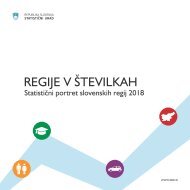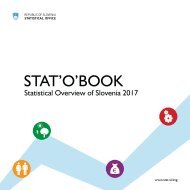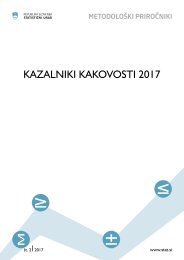quality-indicators-2017
Create successful ePaper yourself
Turn your PDF publications into a flip-book with our unique Google optimized e-Paper software.
QUALITY INDICATORS <strong>2017</strong><br />
1 INTRODUCTION<br />
In the last decade, monitoring of the <strong>quality</strong> of statistical results and systematic reporting on "perceived" <strong>quality</strong><br />
as a consequence of such monitoring have become a regular practice of statistical offices and other providers of<br />
official statistical activities in the European Statistical System (ESS). The fact that such standardised monitoring<br />
and reporting is possible is largely due to the work of a special Working Group on Quality in Statistics, which<br />
has been active under the auspices of Eurostat since 1998 and involves all ESS Member States. As part of its<br />
work, the Group defined the basic concepts and orientations for more comprehensive and harmonised<br />
monitoring of <strong>quality</strong>.<br />
One of the most important results of the mentioned activities is certainly the development of a standardised<br />
method of <strong>quality</strong> reporting. Methodological documents that define the standard reporting structure, called the<br />
Standard Quality Report, together with the methodological documents that describe the rules on how such<br />
documents should be composed, have thus become the basic tools in <strong>quality</strong> reporting. These documents<br />
define in detail six dimensions of the <strong>quality</strong> of statistical results: relevance, accuracy, timeliness and<br />
punctuality, accessibility and clarity, comparability, and coherence. An additional seventh dimension is the cost<br />
and burden on the respondent; although this is not an explicit <strong>quality</strong> dimension, it has a considerable impact on<br />
all dimensions.<br />
Another important part of each report is also the <strong>quality</strong> <strong>indicators</strong> that express the level of <strong>quality</strong> of individual<br />
dimensions in numeric values. Their purpose is to offer the producers of statistics analytical insight into the<br />
statistical procedure as a whole and to provide the users of statistical results important additional information<br />
enabling more correct and appropriate application of results. At the end of 2003, Eurostat's working group<br />
drafted the first list of standard <strong>quality</strong> <strong>indicators</strong> to be integrated into <strong>quality</strong> reports. Although the list was later<br />
slightly modified and adapted, the "core" of these <strong>indicators</strong> has remained the same.<br />
The Statistical Office of the Republic of Slovenia (hereinafter: SURS) began developing its systematic and<br />
standardised approach to <strong>quality</strong> assessment and reporting on the <strong>quality</strong> of its products in 2002. Eurostat's<br />
documents were the basis for methodological guidelines for drafting <strong>quality</strong> reports and for the list of standard<br />
<strong>quality</strong> <strong>indicators</strong> adapted for internal use. Initially, standard <strong>quality</strong> reports were produced for internal needs<br />
and for reporting to Eurostat, while in 2006 SURS also prepared the first reports that were published on its<br />
website. Since then, the production and publication of <strong>quality</strong> reports has been a standard practice of SURS.<br />
Two types of reports are produced: a standard <strong>quality</strong> report and an annual <strong>quality</strong> report. The first report<br />
contains comprehensive descriptions of all <strong>quality</strong> dimensions and is produced every 5 to 10 years for each<br />
survey, while the second is much shorter; it mostly contains the presentation of <strong>quality</strong> <strong>indicators</strong> and is<br />
published annually.<br />
Practical experience in the production of <strong>quality</strong> reports in past years as well as methodological updates at the<br />
European level have shown that methodological documents serving as guidelines for the production of <strong>quality</strong><br />
reports need to be reviewed and amended. This is why SURS produced the first edition of the methodological<br />
manual Quality Indicators in 2011, which contained a description of the standard <strong>quality</strong> <strong>indicators</strong> with practical<br />
instructions for their calculation. The present document is the second edition of the manual and provides a partly<br />
updated and amended description of <strong>indicators</strong> in comparison to the first edition. The amendments are<br />
described in the last chapter of this document.<br />
In addition to the list and description of standard <strong>quality</strong> <strong>indicators</strong>, this document contains a further three<br />
sections. The first additional section describes the adjustment of <strong>indicators</strong> in surveys that are based (partly or<br />
entirely) on administrative sources, the second additional section contains recommendations on the calculation<br />
of <strong>quality</strong> <strong>indicators</strong> at the macro level, while the third describes the general application for the calculation of<br />
<strong>quality</strong> <strong>indicators</strong> developed by SURS in recent years.<br />
7


